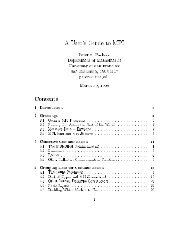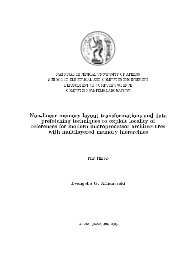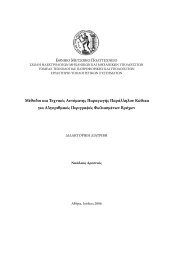Fast and Cost-Effective Online Load-Balancing in - Computing ...
Fast and Cost-Effective Online Load-Balancing in - Computing ...
Fast and Cost-Effective Online Load-Balancing in - Computing ...
Create successful ePaper yourself
Turn your PDF publications into a flip-book with our unique Google optimized e-Paper software.
KONSTANTINOU ET AL.: FAST AND COST-EFFECTIVE ONLINE LOAD-BALANCING IN DISTRIBUTED RANGE-QUERIABLE SYSTEMS 1353<br />
Fig. 4. Worst case of <strong>in</strong>itial setup <strong>and</strong> converged balanced network for the NIX <strong>and</strong> MIG cases.<br />
for: item exchanges between nodes (C itx ), overlay ma<strong>in</strong>tenance<br />
dur<strong>in</strong>g migrations (C ovm ), <strong>and</strong> locat<strong>in</strong>g underloaded basically the cost for a node <strong>in</strong>sertion or deletion (see<br />
item exchanges then is C itx ¼ ðN 1ÞM N<br />
N 1<br />
¼ Oð M NÞ which is<br />
nodes, where <strong>in</strong> each migration M N<br />
keys are offloaded from a number of NIX operations. Node A is located between<br />
N<br />
P 1 to the helper. F<strong>in</strong>ally (fourth picture of Fig. 4), a total of nodes that their load is near their thres value (left side of<br />
N 1<br />
i¼1 M N ¼ðN 1Þ M N keys are transferred. The cost for Fig. 6). In this situation, a cha<strong>in</strong> of NIX operations would<br />
peers dur<strong>in</strong>g prob<strong>in</strong>g (C prb ).<br />
In Theorems 1 <strong>and</strong> 2, we use the aggregate method of<br />
amortized analysis to calculate the average cost of each<br />
balanc<strong>in</strong>g operation <strong>and</strong> completion time of NIX <strong>and</strong> MIG<br />
Theorem 3 of Karger’s work [1]). The prob<strong>in</strong>g cost C prb is<br />
OðlogNÞ s<strong>in</strong>ce it <strong>in</strong>volves contact<strong>in</strong>g logN neighbors.<br />
Moreover, <strong>in</strong> most DHT-like networks, overlay ma<strong>in</strong>tenance<br />
costs C ovm ¼ OðlogNÞ messages. Therefore, the<br />
<strong>in</strong> the worst case of an <strong>in</strong>itial setup (i.e., worst upper bound total MIG cost is C itx þ C ovm þ C prb ¼ Oð M N<br />
of amortized cost). We utilize the notations of Section 2.<br />
Migrations take a constant number of steps as, unlike<br />
Theorem 1. In the worst case, the runn<strong>in</strong>g time of NIX is OðNÞ<br />
<strong>and</strong> the amortized cost per balanc<strong>in</strong>g operation is OðMÞ.<br />
NIX operations, they are executed <strong>in</strong> parallel: therefore,<br />
we consider MIG runn<strong>in</strong>g time to be Oð1Þ (although<br />
Proof. In the first picture of Fig. 4, we present an <strong>in</strong>itial setup<br />
overlay ma<strong>in</strong>tenance usually takes OðlogNÞ time, this can<br />
happen lazily after the key transfer phase).<br />
tu<br />
of node <strong>and</strong> item comb<strong>in</strong>ation that leads NIX to its worst<br />
behavior <strong>in</strong> terms of completion time <strong>and</strong> item exchanges.<br />
To ga<strong>in</strong> <strong>in</strong>sight <strong>in</strong>to the behavior of the two algorithms<br />
Buckets represent nodes <strong>and</strong> balls depict items. Bars<br />
<strong>in</strong> a more general case, let us consider a typical “balls <strong>in</strong>to<br />
above items represent the unit item load l j ¼ 1. For<br />
b<strong>in</strong>s” setup, with N items be<strong>in</strong>g uniformly distributed<br />
simplicity, we consider that for each node, thres i ¼ 1. At<br />
among N nodes (we only consider N out of M items, s<strong>in</strong>ce<br />
the beg<strong>in</strong>n<strong>in</strong>g, N 1 conta<strong>in</strong>s all M objects, of which only the<br />
these items affect node loads). The fraction of underloaded<br />
leftmost N are requested (i.e., they have l j ¼ 1;j2ð0;NŠ)<br />
<strong>and</strong> the rest M-N are not queried (i.e., l j ¼ 0;<br />
nodes, i.e., nodes with a load less or equal to 1, is<br />
j 2ðM N;MŠ). All other nodes are empty. S<strong>in</strong>ce<br />
calculated by estimat<strong>in</strong>g the probability of a node to hold<br />
L 1 ¼ N > thres 1 , N 1 will perform a NIX operation with<br />
either one or no popular item. Utiliz<strong>in</strong>g the equation that<br />
its neighbor N 2 at t 0 <strong>and</strong> it will transfer to it a total of M 1 calculates the probability of a particular b<strong>in</strong> to have exactly<br />
keys, keep<strong>in</strong>g only the leftmost key, so that L 1 ¼ l 1 ¼ k balls we have: P½N j is underloadedŠ ¼ P 1<br />
k¼0 P ½L j ¼ kŠ ¼<br />
P 1<br />
1











